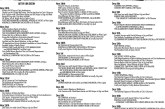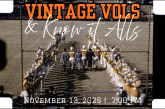New book and exhibit bring forgotten country great into the light
Knoxville is full of great music stories, many of which are still waiting to be told.
Bradley Reeves knew it was time to tell Carl Butler’s story. “Honky Tonkitis: On the Road with Carl Butler and Pearl,” written by Reeves with Nashville’s David D. Duncan, is both a revelation of information about underappreciated country greats Carl and Pearl Butler as well as general Knoxville and Nashville music history.
Full disclosure: Bradley and I worked on the book part of the Grammy-nominated Bear Family Records release “Arthur Q. Smith: The Trouble With the Truth” together a few years ago. Bradley is a history buff like few others and can sniff out sources for facts like a chain-gang bloodhound. Among his many accomplishments, Bradley co-founded the Tennessee Archive of Moving Image and Sound and since then has found material that has changed music and Knoxville history.
Bradley located Carl’s brother Allen Butler Jr. while researching “The Trouble With the Truth.” Carl bought many songs from Smith, and, like most who bought songs from Smith, claimed the songs as his own creations. Butler, though, enjoyed more commercial success than Smith.
Carl Butler, and later with his wife Pearl, enjoyed several hits on the country charts and spent nearly their entire lives touring and performing. The duo’s best-known song is, undoubtedly, “Don’t Let Me Cross Over.” Written by fellow Knoxvillian Penny Jay, the song topped the Billboard Country Singles chart for 11 weeks in 1962. It’s now regarded as a classic. It’s been covered by Jim Reeves and Deborah Allen, Jerry Lee Lewis and Linda Gail Lewis, Dolly Parton and Raul Malo and many others. Still, it’s the Carl Butler and Pearl version that is the definitive version.
“Like Arthur Q., there’s a lot of tragedy, but also a lot more happiness than the Arthur Q. story,” says Bradley.
In Carl’s brother, Allen, now 92, Bradley found someone who was as obsessive as himself in preserving history.
During his brother’s heyday, Allen owned a bar in Knoxville’s Happy Holler area and kept his brother’s singles on the jukebox. After Carl died, Allen inherited his brother’s enormous collection of memorabilia and worked to keep his brother’s legacy alive.
Bradley was eager to embrace that legacy and make sure it was documented.
He spent time in Tellico Plains, where Butler’s mother, Fannie (who went by “Annie”) Butler had grown up. She was orphaned in 1911 after her widowed father committed a heinous murder and then was himself killed. By 1920, she was living in Knoxville. Bradley found Carl Butler’s birth certificate in a trunk on the Franklin, Tennessee, property that Carl Butler once owned and sold near the end of his life. The birth certificate from 1924 listed no name for Carl’s father.
“The mystery of Carl’s father may never be known,” says Bradley. “Allen was Carl’s half-brother, but they never treated each other as anything but brothers. Carl was Allen’s hero when they were growing up.”
While the family generally lived in poverty in the Happy Holler and Lonsdale communities, Carl’s mother made sure her eldest son had a guitar. It was Carl’s dream, even at a young age, to perform on the Grand Ole Opry in Nashville.
By the age of 17 or 18 (in 1942), Carl had his own radio show on the fledgling radio station WBIR.
Not long after, Butler served in World War II. While he attempted other jobs than music after his discharge in 1945, by 1947, he was again making a living in music.
Bradley says it was a surprise to find that Butler was part of the band the Dixie Partners with local legends Bonnie Lou and Buster. A bluegrass collector in Italy actually found a radio transcription from 1947 with Butler singing “Lonesome Road” with the band and shared it with Bradley.
It was also in 1947 when Butler married his girlfriend Pearl Jones. While it was years before she became part of his music act, she was Carl’s champion from that moment on.
In 1948, Butler’s career was nearly ended when he, future bluegrass bass legend Jake Tullock and 14-year-old future songwriting legend L. E. White were returning to Knoxville from a gig in Kingsport and White, who had been enlisted to drive, fell asleep at the wheel.
The car hit a concrete pillar, and Carl was badly injured. Local millionaire grocer and music entrepreneur Cas Walker footed the bill for Butler’s surgery (including plastic surgery) and staged a benefit concert. The Butlers were forever indebted.
“He was back on the road in six months,” says Bradley.
Butler began his recording career in 1950 with Capitol Records and recorded in a studio in Knoxville’s Hamilton Bank building downtown.
“They were great bluegrass records,” says Bradley. “Then Capitol dropped him after about a year, and Columbia picked him up and THOSE records were even better!”
With Columbia, Butler tried a number of different styles to get a hit, but nothing panned out. Some of his songs, many actually written by Arthur Q. Smith, did bring in some income, though. Working tirelessly with diminishing returns as the 1950s went on, Carl had a series of nervous breakdowns.
“In 1957, Pearl got him out of the hospital and said, ‘We’re going to Nashville,’” says Bradley.
The next year, Butler was made a regular performer on the Grand Ole Opry.
In 1961, Carl Butler had his first Billboard Country Singles hit with “Honky Tonkitis,” which went to No. 25. However, it wasn’t until Pearl joined Carl on the song “Don’t Let Me Cross Over” (credited to “Carl Butler and Pearl”) that the act hit paydirt.
That one song, a massive hit, changed everything.
“They got that first royalty check, and they were like kids in a candy store,” says Bradley. “They’d both grown up in abject poverty. They bought a farm and house in Franklin [which they dubbed Crossover Acres] and had their parents move in – his mom and her dad – and they invited anybody and everybody over.”
Hits followed, including “Loving Arms,” “Too Late to Try Again” and “My Tears Don’t Show.” The duo scored minor hits throughout the following decade, as well, and they toured constantly for the next 20 years.
“Just studying the catalog of Carl Butler and Pearl is great,” says Bradley. “Those albums, there’s not a bad cut on any of them.”
While it’s unfortunate that the duo didn’t get the respect they deserved, Carl inadvertently made sure that the history was there so that they might be appreciated in the future.
“Carl basically wrote his own book,” says Bradley. “He saved everything – promotional materials, lyrics, reel-to-reel tapes, home movies, unreleased music …”
Butler had more than 3,000 photos and films, which included everything from local entertainers, including Dolly Parton whom the Butlers had befriended when she was still a preteen, to Nashville greats. There were photos from Knoxville music venues that are now long gone, along with musicians who never made top-tier status but were beloved parts of both the Knoxville and Nashville music scenes. There’s a 1982 cassette recording of Carl with bluegrass father Bill Monroe playing songs and cutting up.
The hits and radio play became infrequent in the 1970s as changes occurred in country music, but Bradley says the music that Carl Butler recorded remained vital.
“He had the A-level Nashville team backing them up,” says Bradley. “He was truly great.”
It is a shame, he says, that the music of Carl Butler and Pearl did not garner reappreciation during the new traditionalist movement in country music in the 1980s.
Pearl died of a thyroid condition in 1988. Carl, meanwhile, had to sell the couple’s farm to make ends meet and died of a heart attack in 1992 while living in a trailer.
“When he died, they had to get his guitar out of a pawn shop,” says Bradley. “He left his broken-down Cadillac at Crossover Acres. His story is probably actually more tragic than what I’ve written.”
Yet the authors are lucky that Allen Butler, who allowed Bradley full access to his brother’s archives, was supportive of a truthful story being told.
While Carl had maintained that he himself had written songs he bought from Arthur Q. Smith, Allen didn’t mind setting the record straight. Carl had, in fact, bought some of his most popular tunes from Smith and kept a record of it. Allen had acetate recordings and other records in a trunk that his brother had squirreled away.
Bradley is just as happy that Carl Butler kept photographs and records of what he calls “the second tier” of Knoxville and Nashville performers, who are rarely celebrated.
“These are people who kept going and playing until the end of their lives,” says Bradley. “They were putting 100,000 miles on their cars every year.”
Because of Reeves, Duncan and some other folks, Carl and Pearl Butler will at least have an appreciation in their hometown, and the book will provide a timeless document. Famed music historian Colin Escott wrote an introduction to the book, and local graphic designer Jody Collins created its cover.
The celebration at the East Tennessee History Center will begin at 5 p.m. on Oct. 6 and will include musical performances by Knoxville-born great Paul Brewster and bluegrass prodigy Wyatt Ellis beginning at 7 p.m. The exhibit officially opens to the public on Oct. 7.








